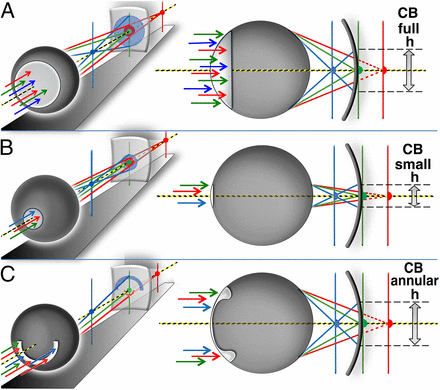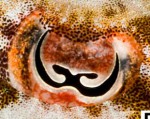This is kind of awesome: cephalopods only have one kind of photoreceptor, so it was thought that they would be only able to see the world in shades of gray. Those amazingly clever camouflage tricks they pull? That was just matching intensities and textures, fooling our eyes. But now someone has figured out a way they could see color, and special bonus, it also explains those funky weird pupil shapes, like you see in the cuttlefish eye to the right.
They use chromatic aberration! We think of chromatic aberration as an imaging problem — it’s caused by the fact that the degree refraction of light is partly dependent on wavelength, so the blue light in an image focuses closer to the lens than the red light. When you focus optimally on the green wavelengths, for instance, that means that the red and blue colors form an out of focus, blurry image on top of the sharp greens, producing a pattern of color fringes around objects. They jump out clearly to me when I use the cheap student microscopes here, and are why I spent a lot of extra money getting planapochromat lenses for my microscope. They have lots of corrective glass to tweak the different wavelengths into the same focal plane.
But where I see an annoyance, cephalopods evolved an opportunity. Where an object comes into sharpest focus on the eye can actually tell you what wavelengths are — so by focusing backwards and forwards on something, they can extract a rough idea of its color.
And that leads into the next nifty explanation. Where I want to minimize chromatic aberration, cephalopods want to increase it…and as it turns out, having weird off-axis apertures causes more disparity in the focal plane of different wavelengths of light, which makes it easier to discriminate color using this mechanism.

Chromatic blur and pupil geometry. The (A) full and (C) annular aperture pupils produce more chromatic blurring (CB) than (B) the small on-axis pupil, because they transmit rays with a larger ray height h. Vertical lines show best focus positions for blue, green, and red light.
It’s settled then. Cephalopods are cleverer than we are. Or maybe it’s evolution that is smarter than we are. One of those two.
Stubbs AL, Stubbs CW (2016) Spectral discrimination in color blind animals via chromatic aberration and pupil shape. Proc Natl Acad Sci U S A. 2016 Jul 5. pii: 201524578. [Epub ahead of print]



This is one of those sciency things that makes me jump up and yell ‘That is so fucking cool!’ and give away my age etc but I’m so excited I cannot be arsed to be embarrassed.
And just to add PZ – your planapochromatic lenses are no longer worth shit! By the end of the week someone will have worked out the algorithm to apply this to 30c CCD chips and instagram will turn into a black hole due as the information poured into it reaches critical mass!
Absolutely amazing! Cephalopod for president!
Pretty damn cool. I was looking at this on Phys Org earlier today.
What’s interesting is that they might fail a color perception test with uniformly colored flat surfaces as there would be no detail to establish the focal depth. Not a big problem in the big lumpy world but only in the lab. I wonder if they see color as a characteristic of edges rather than interior surfaces. Does this mean their eyes are constantly oscillating the focus?
You biologists keep this up, PZ, and pretty soon you’ll end up being applied physicists. Then nothing stops you from making utterly wrong pronouncements on pretty much every topic you encounter. Beware!
Seriously, though, that is the coolest thing I’ve learned today by far.
Biologists are already physicists — also mathematicians, chemists, and whatever other -ist you’ve got.
Yes, their eyes constantly change focus, but so do yours. Their brains are just extracting another piece of information from the image while they do it.
So I’m assuming that this also explains the wierdness of goat’s eyes as well.
Now I wonder how good a squid’s color discernment is. Because this is kind of a novel way to take a coarse spectrum of things, unlike we puny mammals who have to just do tri-color photometry. (Aka how bright/dark is a thing in three bands of color.)
But that’s really cool and not something I wouldn’t have thought of as a way to see color despite it being a known optical problem for those folks who rely on lenses.
That is so cool! I wonder if this affects how they perceive color. After all, we see color as an extension of it’s brightness (kinda, I guess), wouldn’t they see it as a spatial effect? After all the focal plane would depend on both distance and color.
For distant objects, the point of focus will depend solely on color but for objects up close there is a discrimination problem: and object can focus closer because it is closer or because it is more blue. Thus a card that shades from red to blue could appear to a squid as having one edge closer than the other. It would be interesting to see if the squid pupil opening is also oscillated so as to vary the relative proportions of light from the center and edges so as to scan the amount of aberration and give a mechanism to distinguish distance changes from color changes. I wonder if the very rapid flashing patterns that squids make take on 3D appearance as they get ahead of the pupil opening changes.
— in other words, there may be some really interesting optical illusions specific to squid vision.
–wants to mess with squids heads..
One other feature of the pupil shape is that the pupil opening can be varied to adjust for light brightness changes without changing the amount of color aberration- the squids depth of focus won’t increase with brighter lighting. Squid color perception might (not sure?) be less affected by the increasing blueness of sunlight with depth.
My point about color being a feature of edges for squids is shown by looking at images such as those in
https://en.wikipedia.org/wiki/Chromatic_aberration
Thomas Scott wrote:
It may be part of it, but the horizontal slit aparently has a bunch of other benefits: https://www.washingtonpost.com/news/speaking-of-science/wp/2015/08/10/heres-why-goats-have-those-freaky-eyes/
In short, it helps keep the sunlight from blinding them while allowing lots of light into the eye, and increases field of vision.
Remarkable. Reminds me of this comic: http://www.schlockmercenary.com/2008-04-29
(cf. #8)
So basically, they have a built in spectrum analyser. That is, indeed, cool.
I have always been very skeptical of the claim that Cephalopods are unable to detect color.
Watch how well they can color match a variable color background when attempting to hide!
@bcwebb #14: Great minds think alike.
Evolution is useful because you can make predictions. Given that, I predict that cdesign proponentsists will be using this cephalopod chromatic aberration discovery in some upcoming paper or presentation. Hey, it’s complicated!